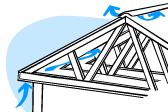
Hot air naturally rises, and ridge vents are an effective way of allowing this heat to easily escape through the highest point in a home – the ridge of the roof.
Ridge vents are an excellent way to improve the airflow in your ceiling space. By allowing heat out of the roof, ridge vents let you control and manage excess heat gain in your home.

How do ridge vents work?
A ridge vent sits at the very peak of your roof, allowing cool air into your ceiling cavity while also allowing hot air to escape. Ridge vents are most commonly found on shingled roofs. Installing a ridge vent involves leaving a gap between the two sides of your roof at the ridge, then covering that gap with a slightly elevated shingle to allow room for the hot air to escape. These types of vents often incorporate a baffle or a grill-like mechanism to help ensure that rain doesn’t leak into your ceiling space.
Roof ridge ventilation is better suited to homes that have a low-pitched roof, to allow heat to escape more easily.
How effective are they?
Put simply, they’re fairly ineffective on their own. Ridge vents work best as part of a system that helps to force hot air into the ceiling cavity and out through the ridge vent.
Where some ventilation systems will naturally create a vacuum effect, ridge vents generally don’t so they require hot air to be forcibly pushed towards them. This is often achieved either with the use of soffit vents to create a flow of air up through the eaves and out through the ridge, or with a powered ventilation system like a whole-house fan.
|
Advantages
|
Disadvantages
|





